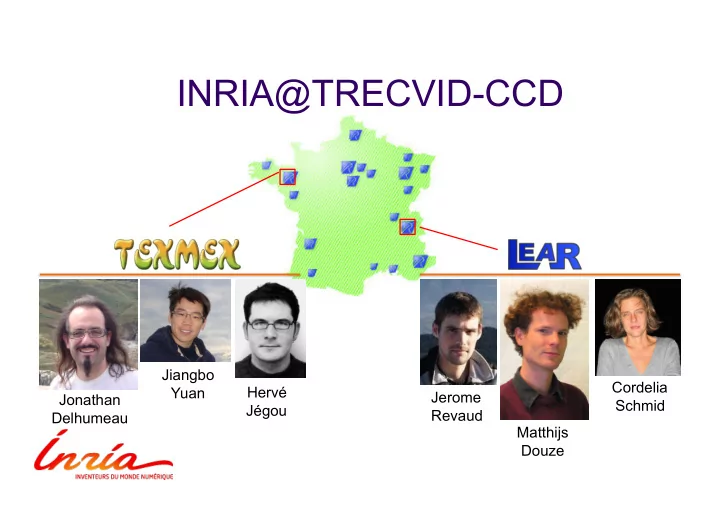

INRIA@TRECVID-CCD Jiangbo Cordelia Hervé Yuan Jerome Jonathan Schmid Jégou Revaud Delhumeau Matthijs Douze
Conclusions and questions from last year What are the individual contributions of audio and video ? Audio weaker than video, apparently ► But complementary to image ► Further improvement possible ? Fusion step is critical ► Is early fusion an option ? Scoring strategies to optimize NDCR looks critical ► Keep maximum 1 result per query ?
Our Runs at Trecvid 5 runs to measure the individual contributions of our system 2 runs designed for “best” search quality: the DODO runs
Video visual system: ingredients (same as in 2010) Local descriptors: CS-LBP Weak geometric consistency Hamming Embedding Burstiness strategy Improve bag-of-features ► + Multi-probe
Audio system: basic ingredients (same as in 2010) Base descriptor: Filter Compounding banks f 1 f 2 f 3 f N 500 Hz 3000 Hz Overall bandwidth 25ms dim. 40 Overlapping temporal analysis 85ms dim. 120 d m Matching: product quantization d 4 d 3 d 2 d 1 0 10 20 10 30 Time (ms)
New ingredient 1: temporal shift DB descriptors 10ms Query misaligned: Not lucky! 5ms Query descriptors: query all shifts (5 * slower!) 2ms shift 4ms shift 6ms shift 8ms shift
New ingredient 2: reciprocal nearest neighbors Audio matches: k-nearest neighbors Pb: if X neighbor of Y, Y not necessarily neighbor of X Weighted Reciprocal nearest neighbors
Audio: improvement over last year 6 times slower in total, for a limited improvement
New ingredient 3: early fusion audio/video Early fusion: ► Input: image & audio raw Hough hypotheses ► Robust time warping to align query frames with DB frames query time Example DB time Audio frame matches of time Image frame matches warping Resulting optimal path matrix:
Early fusion Input: image & audio raw Hough hypotheses 1. Robust time warping - align query frames with db frames 2. Description of matching segments segment length, number of audio/image frame matches, … surface of the image recognized on the database side KL-divergence between db keypoints distribution / matches distribution relative support of image & audio for the hypothesis etc. 3. Classifier produces a score
Early fusion: training the classifier Boosting scheme: ► Each iteration, addition of a new feature Criterion: maximize AP on validation set ► Classifier: Logistic regression (better than SVM here) 40,000 positive samples 150,000 negative examples Result: selected features (sorted) ► Detected area ► Nb of audio & image frame matches ► KL divergence between keypoints distribution ► Length of matching segment in seconds ► Etc…
2010 vs 2011 approach
2010 vs 2011 approach
Analysis: balanced profile (opt-NDCR) RUN AUDIO VIDEO FUSION NDCR (avg) DEAF no yes n/a 0.258 AUDIOONLY yes no n/a 0.406 THEMIS yes yes late 0.211 ZOZO yes yes late 0.194 DODO yes yes early 0.144 One surprise: ZOZO > THEMIS ► Keeping more than 1 result is better if scores are ties
Overview of results (opt-NDCR) Balanced profile NoFa profile RANK INRIA PKU CRIM NTT- RANK INRIA PKU CRIM NTT- CSL CSL 1 5 31 21 1 1 23 14 18 8 2 16 23 8 3 2 10 31 11 7 3 9 2 9 5 3 11 10 13 4 4 19 0 10 7 4 9 1 9 5 5 4 0 4 4 5 3 0 4 7 6 1 0 4 13 6 0 0 1 5 7 2 0 0 12 7 0 0 0 3 PKU and CRIM are much better with Actual-NDCR ► We don’t know how to set the threshold ► This problem may be inherent to our system
Introduction of Babaz audio matching system Open source: http://babaz.gforge.inria.fr/ Well… PQ-codes replaced by k-means LSH (licensing issue) ► Requires more memory (40GB instead of 5GB) and slower ► But PQ-codes Matlab implementation available All Trecvid queries: query times (16 cores), memory, mAP ► Pqcodes – heavy: 20H 5GB mAP = 80.7 % ► Pqcodes – light: 3H 5GB mAP = 78.9 % ► K-means LSH: 25H 40GB mAP = 78.8 % Offline: Pqcodes-h: 69H, Pqcodes-l: 11H, KMLSH: 17H
Questions?
Recommend
More recommend